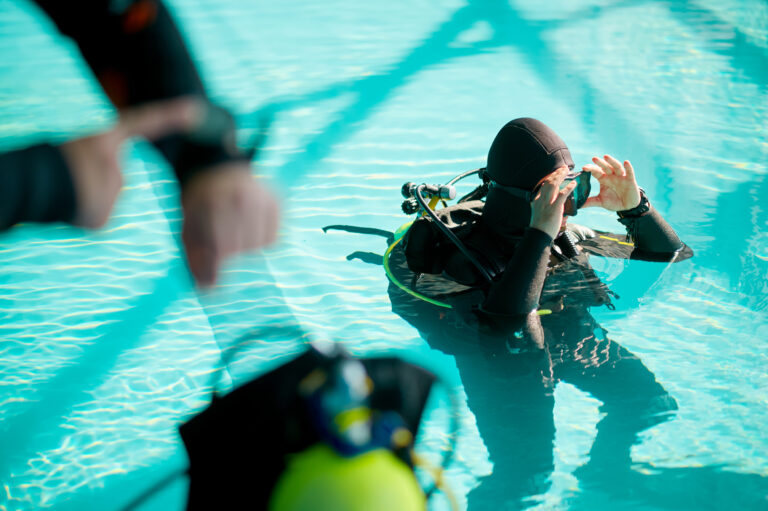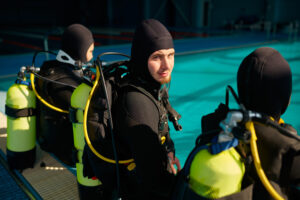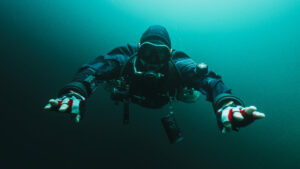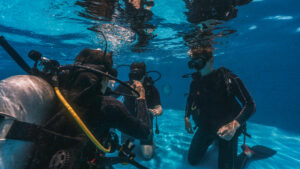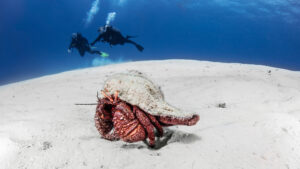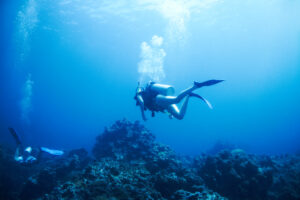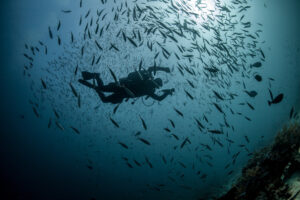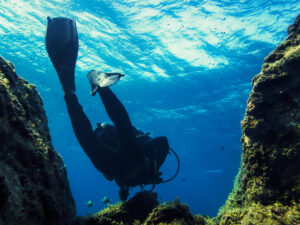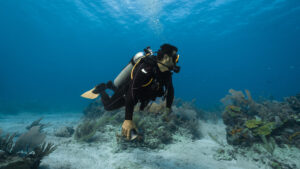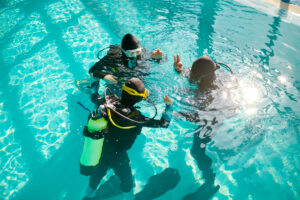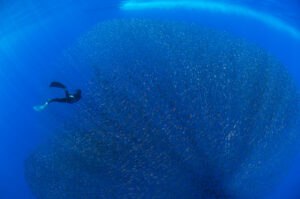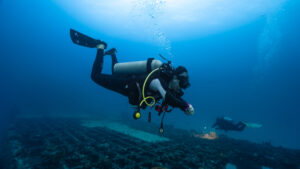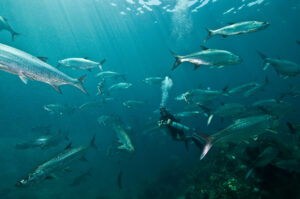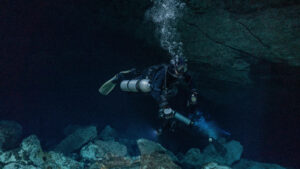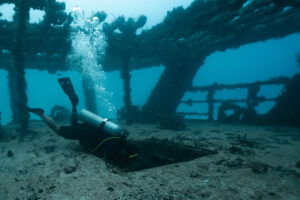What is Entry when Scuba Diving?
Entry techniques in scuba diving are critical for ensuring diver safety and environmental preservation. Proper entry methods allow divers to enter the water with minimal risk of injury and help protect marine environments from damage. Understanding and mastering various entry techniques is essential for divers of all skill levels, as it impacts both the initial moments of the dive and the overall diving experience.
Definition of Entry in Scuba Diving
In scuba diving, “entry” refers to the method by which a diver enters the water from a boat, shore, or other platform. The term encompasses a range of techniques that divers use depending on the environment, diving conditions, and personal preference. Proper entry techniques are crucial for maintaining control and ensuring a smooth transition from the surface to the underwater environment. They help divers avoid injuries, manage their equipment effectively, and start their dives with confidence.
Choosing the right entry method can make a significant difference in the safety and comfort of the dive. Different entry techniques are designed to address specific challenges posed by various diving scenarios. For example, the giant stride entry is often used when entering from a stable platform, while the back roll entry is more suitable for small boats. By understanding the nuances of each entry technique, divers can better prepare for their dives and minimize risks associated with entry.
Mastering entry techniques is also essential for minimizing the impact on the environment. Some entry methods, if performed incorrectly, can cause damage to delicate marine ecosystems, such as coral reefs. By using appropriate entry techniques, divers can help protect these environments and contribute to the sustainability of diving sites. Proper training and practice are necessary to execute these techniques effectively and responsibly.
Types of Entry Techniques
Giant Stride Entry
The giant stride entry is one of the most commonly used methods for entering the water from a boat or a stable platform. This technique involves taking a large step forward from the edge of the platform while maintaining a straight posture. The giant stride entry is ideal for situations where the water surface is calm, and the entry point is relatively high above the water. This method allows divers to enter the water with minimal splash and maintain control of their equipment.
To perform the giant stride entry, the diver first stands at the edge of the platform with their fins dangling over the side. Holding their mask and regulator in place with one hand, the diver takes a large step forward, extending one leg out while pushing off with the other. As the diver enters the water, they bring their legs together to streamline their entry and prevent entanglement with their equipment. It is essential to keep the body upright and look straight ahead to ensure a smooth entry.
The giant stride entry is suitable for a wide range of diving conditions, making it a versatile technique for divers. It is particularly useful when entering from a high platform, as it allows for a controlled descent into the water. This method is also effective in minimizing the impact on the marine environment, as it produces minimal turbulence and disturbance.
Back Roll Entry
The back roll entry is commonly used when entering the water from small boats, such as inflatable dinghies or RIBs (rigid inflatable boats). This technique involves rolling backward into the water from a seated position on the edge of the boat. The back roll entry is ideal for situations where the entry point is close to the water surface and there is limited space on the boat. This method allows divers to enter the water quickly and efficiently while maintaining control of their equipment.
To perform the back roll entry, the diver sits on the edge of the boat with their back facing the water. Holding their mask and regulator in place with one hand, the diver tucks their chin to their chest and rolls backward into the water. As the diver enters the water, they should keep their legs together and extend them slightly to streamline their entry. It is essential to exhale gently as the diver rolls backward to prevent water from entering the mask and regulator.
The back roll entry is well-suited for small boats, where space is limited, and divers need to enter the water quickly. This technique allows for a controlled and smooth entry, minimizing the risk of injury and equipment entanglement. It is also effective in reducing the impact on the marine environment, as it produces minimal disturbance and turbulence.
Controlled Seated Entry
The controlled seated entry is a technique used when entering the water from a low platform or shoreline. This method involves sitting on the edge of the platform and gently sliding into the water. The controlled seated entry is ideal for situations where the entry point is close to the water surface and the platform is stable. This method allows divers to enter the water gradually and maintain control of their equipment.
To perform the controlled seated entry, the diver sits on the edge of the platform with their legs dangling over the side. Holding their mask and regulator in place with one hand, the diver gently slides forward, allowing their body to enter the water slowly. As the diver enters the water, they should keep their legs together and extend them slightly to streamline their entry. It is essential to exhale gently to prevent water from entering the mask and regulator.
The controlled seated entry is suitable for a wide range of diving conditions, making it a versatile technique for divers. It is particularly useful when entering from a low platform, as it allows for a gradual and controlled descent into the water. This method is also effective in minimizing the impact on the marine environment, as it produces minimal turbulence and disturbance.
Factors Affecting Entry Choice
Environmental Conditions
Environmental conditions play a crucial role in determining the appropriate entry method for a dive. Factors such as wave size, tide, and current can significantly impact the safety and effectiveness of different entry techniques. Understanding and assessing these conditions before choosing an entry method is essential for ensuring a safe and successful dive.
Wave size is one of the most critical factors to consider when selecting an entry technique. Large waves can make entry more challenging and increase the risk of injury. In such conditions, the giant stride entry may be preferable, as it allows divers to enter the water quickly and with minimal splash. Conversely, the back roll entry may be more suitable in calmer waters, where the risk of being knocked off balance by waves is lower.
Tide and current also influence the choice of entry method. Strong currents can make it difficult for divers to maintain control during entry, increasing the risk of being swept away. In these conditions, the controlled seated entry may be more appropriate, as it allows for a gradual and controlled descent into the water. This method minimizes the risk of being affected by strong currents and ensures a safer entry.
Understanding local conditions and how they affect entry methods is essential for ensuring a safe and successful dive. By considering environmental factors such as wave size, tide, and current, divers can choose the most appropriate entry technique for their specific situation.
Type of Diving
The type of diving being undertaken also plays a significant role in determining the appropriate entry method. Different entry techniques may be more suitable for recreational diving, research diving, or rescue diving, depending on the specific requirements and goals of the dive. Considering the type of diving and the associated challenges is essential for selecting the most effective entry method.
Recreational diving typically involves exploring underwater environments for enjoyment and relaxation. In these situations, divers may prefer entry techniques that allow for a smooth and controlled descent into the water. The giant stride entry and the controlled seated entry are often preferred for recreational diving, as they provide a comfortable and stable entry.
Research diving, on the other hand, often involves conducting scientific studies and collecting data underwater. This type of diving may require more specialized equipment and procedures, which can influence the choice of entry method. For example, the back roll entry may be preferred when using small boats for research diving, as it allows for a quick and efficient entry.
Rescue diving involves responding to emergencies and providing assistance to other divers in distress. In these situations, speed and efficiency are critical, and the choice of entry method can significantly impact the success of the rescue operation. The back roll entry is often preferred for rescue diving, as it allows for a rapid and controlled entry into the water.
Considering the specific requirements and challenges associated with different types of diving is essential for selecting the most appropriate entry technique. By understanding the goals and conditions of the dive, divers can choose the entry method that best meets their needs.
Safety Considerations
Safety is a paramount concern when performing any entry technique in scuba diving. Proper execution of entry methods is crucial for minimizing the risk of injury and ensuring a smooth transition from the surface to the underwater environment. Understanding and adhering to safety measures is essential for all divers, regardless of their skill level or experience.
One of the primary safety considerations when performing entry techniques is the proper handling of equipment. Ensuring that masks, regulators, and other gear are securely in place before entering the water is crucial for maintaining control and preventing equipment loss. Divers should always perform pre-dive checks to ensure that all equipment is functioning correctly and securely fastened.
Another important safety consideration is maintaining control during the entry. Sudden or uncontrolled movements can lead to injury or equipment entanglement. Divers should focus on executing the entry technique smoothly and deliberately, keeping their body streamlined and minimizing unnecessary movements. This approach helps prevent accidents and ensures a safe entry into the water.
Understanding and mitigating common risks associated with different entry techniques is also essential for ensuring safety. For example, the giant stride entry can pose a risk of injury if the diver’s legs are not properly extended or if the entry is performed from too high a platform. Similarly, the back roll entry can be hazardous if the diver fails to protect their mask and regulator during the roll. By being aware of these risks and taking appropriate precautions, divers can minimize the likelihood of accidents and injuries.
Environmental Considerations
Minimizing the environmental impact of entry techniques is a crucial aspect of responsible scuba diving. Different entry methods can have varying effects on marine ecosystems, and understanding these impacts is essential for protecting underwater environments. Divers should strive to use entry techniques that minimize disturbance and avoid damaging sensitive marine habitats.
One of the primary environmental considerations when performing entry techniques is the potential for physical damage to marine ecosystems. Coral reefs, seagrass beds, and other underwater habitats can be easily damaged by careless or improper entries. Divers should aim to enter the water gently and avoid making contact with the seafloor or other underwater structures. The controlled seated entry, for example, allows for a gradual and gentle entry that minimizes physical impact on the environment.
Another important consideration is the potential for stirring up sediment and creating turbidity in the water. This can have a negative impact on marine life and reduce visibility for other divers. Entry techniques that produce minimal splash and turbulence, such as the giant stride entry, are preferable in areas with sensitive ecosystems. By choosing entry methods that reduce sediment disturbance, divers can help preserve the clarity and quality of the underwater environment.
Responsible diving practices also involve being aware of the presence of marine life and avoiding unnecessary disturbances. Divers should always be mindful of their surroundings and take care to avoid startling or harming marine animals during their entry. This consideration is particularly important in areas with high biodiversity, where the presence of sensitive or endangered species may require additional caution.
Training and Certification
Training and certification play a vital role in ensuring that divers are proficient in performing entry techniques safely and effectively. Various training programs and certification courses focus on teaching divers the skills and knowledge needed to execute different entry methods. These programs emphasize the importance of proper technique, safety measures, and environmental considerations.
Scuba diving certification courses, such as those offered by organizations like PADI and NAUI, typically include training on entry techniques as part of their curriculum. These courses provide divers with hands-on experience and instruction on performing various entry methods. By completing these courses, divers gain the skills and confidence needed to execute entry techniques safely and responsibly.
Continuing education and practice are also essential for maintaining proficiency in entry techniques. Advanced training programs and specialty courses offer opportunities for divers to refine their skills and learn new techniques. Regular practice and repetition help divers maintain muscle memory and ensure that they can perform entry techniques smoothly and confidently.
The importance of proper training and certification cannot be overstated when it comes to entry techniques in scuba diving. By investing in quality education and ongoing practice, divers can enhance their skills, improve their safety, and contribute to the protection of marine environments.
Key Takeaways
Mastering entry techniques in scuba diving is essential for ensuring safety and minimizing environmental impact. Understanding the different methods, such as the giant stride, back roll, and controlled seated entry, allows divers to choose the most appropriate technique based on environmental conditions and the type of diving. Proper training and adherence to safety measures are crucial for executing these techniques effectively. By being mindful of their entry methods, divers can enhance their underwater experiences while protecting the delicate marine ecosystems they explore.

